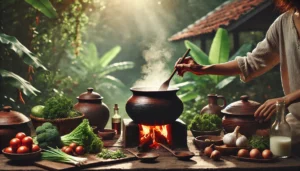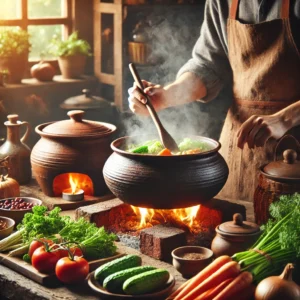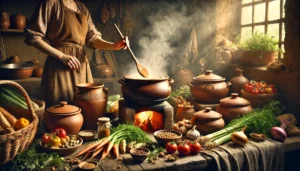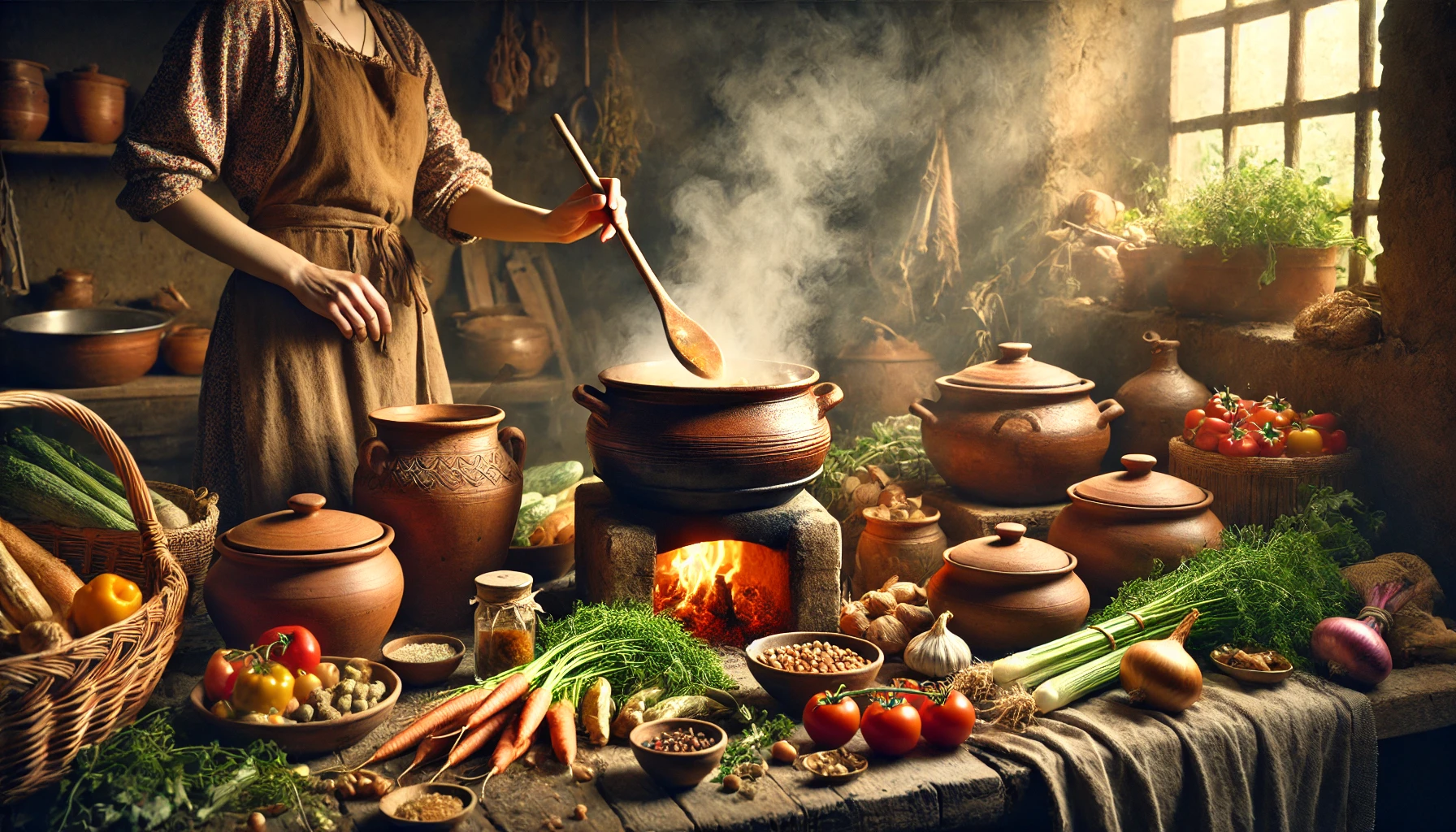
How clay pots improve food taste naturally
Cooking in clay pots: Benefits and techniques
Cooking in clay pots is a traditional method that has been practiced for centuries across various cultures. In recent years, it has gained renewed popularity due to its numerous health benefits and the unique flavor it imparts to food. Clay pot cooking is often associated with rustic, home-style meals, but it is versatile enough to be used for a variety of cuisines and sophisticated dishes. This article explores the benefits of cooking in clay pots, provides techniques to get the best results, and offers tips on incorporating this method into modern kitchens.
Benefits of Cooking in Clay Pots
- Enhanced Flavor: Clay pots allow slow and even cooking, enhancing the natural flavors of ingredients. The porous nature of clay helps retain moisture, resulting in juicy and tender dishes. It also allows gentle evaporation, intensifying the aroma and taste.
- Nutrient Retention: Cooking in clay pots preserves nutrients better compared to metal or non-stick cookware. The gentle cooking process prevents the loss of vitamins and minerals, ensuring meals are both flavorful and nutritious.
- Reduced Oil Usage: The moisture-retaining properties reduce the need for excess oil, promoting healthier cooking. Less oil means lower calorie intake, making clay pot cooking ideal for those aiming to maintain a balanced diet.
- Alkaline Properties: Clay is naturally alkaline, which helps neutralize acidity in food and balances pH levels, making meals easier to digest. This can be particularly beneficial for people with digestive issues.
- Chemical-Free Cooking: Unlike non-stick or metal cookware, clay pots are free from harmful chemicals and synthetic coatings. Cooking in unglazed clay pots eliminates the risk of toxins leaching into food.
- Eco-Friendly: Clay pots are biodegradable and made from natural materials, making them an environmentally friendly choice compared to synthetic or metal cookware.
Table of Contents

How clay pots improve food taste naturally
Techniques for Cooking in Clay Pots
- Seasoning the Pot: Before using a new clay pot, soak it in water for 12-24 hours and then dry it. Rub the interior with oil and heat it slowly. This seasoning process strengthens the pot and prevents cracking. Regular seasoning helps maintain the pot’s durability.
- Gradual Heating: Clay pots are sensitive to temperature changes. Always start cooking on low heat and gradually increase to prevent cracking. Sudden heat can weaken the pot, so patience is key.
- Avoid Sudden Temperature Changes: Never place a hot clay pot under cold water or on a cold surface, as this can lead to cracks. Always allow the pot to cool naturally before cleaning.
- Use Wooden Utensils: Metal utensils can damage the pot’s surface. Wooden or silicone utensils are recommended to preserve the pot’s integrity. Gentle handling extends the pot’s lifespan.
- Cleaning and Maintenance: Clean clay pots using warm water and a soft brush. Avoid harsh detergents, as clay absorbs chemicals. For stubborn stains, use baking soda and water. Sun-drying the pot after washing prevents mold formation.
- Storage: Store clay pots in a dry, well-ventilated area. Avoid stacking them directly on each other to prevent chipping or cracking. Placing a soft cloth between pots is a good practice.
Tips for Incorporating Clay Pot Cooking into Modern Kitchens
- Experiment with Diverse Recipes: Clay pots are suitable for a variety of dishes, from stews and soups to bread and rice. Experimenting with different cuisines can help you discover new flavors.
- Adapt Cooking Times: Clay pot cooking often requires longer cooking times compared to conventional methods. Plan meals accordingly to enjoy the full benefits of this traditional technique.
- Combine with Fresh Ingredients: Fresh vegetables, herbs, and spices pair exceptionally well with clay pot cooking. Their flavors are enhanced during the slow-cooking process.
- Embrace the Art of Slow Cooking: Clay pot cooking emphasizes patience and attentiveness. Allowing food to cook slowly ensures rich flavors and tender textures.
Cooking in clay pots is not only a healthier option but also a way to reconnect with age-old culinary traditions. With proper care and techniques, clay pots can enhance your cooking experience and bring out the best in your dishes. Whether preparing a simple meal or a gourmet feast, clay pots offer a rewarding and wholesome way to cook.

How clay pots improve food taste naturally
FAQs on The Art of Clay Pot Cooking: Techniques for Taste and Health Benefits
- What is clay pot cooking?
Clay pot cooking is a traditional culinary technique that uses pots made from natural clay to prepare meals. This method has been practiced for centuries across various cultures, including Asian, Middle Eastern, African, and Mediterranean cuisines. The porous nature of clay allows slow, even cooking while retaining moisture and enhancing the natural flavors of the ingredients.
- What are the primary benefits of cooking in clay pots?
Cooking in clay pots is known for several unique advantages:
- Enhanced Flavor: The slow, even heating process and moisture retention create richer, deeper flavors in dishes.
- Healthier Meals: Requires less oil, as the natural moisture from ingredients is preserved during cooking.
- Nutrient Retention: Slow cooking at lower temperatures helps retain vitamins, minerals, and other nutrients.
- Alkaline Nature: Clay is naturally alkaline, which interacts with acidity in food, helping balance pH levels and reducing acidity.
- Eco-Friendly: Clay pots are biodegradable and made from natural materials, making them an environmentally friendly cooking option.
3. Are clay pots safe for cooking?
Yes, clay pots are generally safe as long as they are made from natural, lead-free clay and do not contain harmful glazes. It’s important to ensure that the pots are labeled “food safe” and are free from toxic substances like lead or cadmium. Avoid using decorative pots, as they might not be intended for cooking.
- How do I season a new clay pot before using it?
Seasoning prepares your clay pot for cooking and prevents cracking:
- Soak the pot: Submerge the pot and its lid in water for 12-24 hours.
- Dry it naturally: Let the pot air-dry completely.
- Apply oil: Rub the interior lightly with cooking oil (such as olive or vegetable oil).
- Heat gradually: Fill the pot with water and place it in a cold oven. Set the temperature to 250°F (120°C) and heat for about 30 minutes. Allow the pot to cool inside the oven.
- Ready for use: The pot is now seasoned and ready for cooking.
5. Can clay pots be used on all types of stovetops and ovens?
Clay pots can be used in ovens, on gas stoves, and over open flames. However:
- Gas Stoves: Always start on low heat and gradually increase to prevent thermal shock.
- Electric Stoves: Not ideal, as direct contact with the heating element can crack the pot.
- Induction Cooktops: Clay pots are not compatible unless designed with an induction base.
- Oven Use: Place the pot in a cold oven and allow it to heat gradually.
6. How should I clean and maintain my clay pot?
Clay pots require special care:
- Avoid Detergents: Since clay is porous, it can absorb soap, which may affect the taste of future dishes.
- Use Warm Water: Clean with warm water and a non-abrasive brush.
- Stubborn Stains: Use a paste of baking soda and water or soak with water and vinegar to remove food residue.
- Dry Thoroughly: Ensure the pot is completely dry before storing to prevent mold.
7. Can I cook a variety of dishes in a clay pot?
Yes, clay pots are versatile and suitable for a range of recipes:
- Stews and Curries: Enhances flavors by slow cooking.
- Rice Dishes: Perfect for biryanis and pilafs, as they cook evenly.
- Soups and Broths: Retains warmth and enhances aroma.
- Meats and Poultry: Tenderizes meat while preserving juices.
- Baking: Suitable for bread and cakes with a rustic crust.
- Vegetarian Dishes: Brings out the natural sweetness of vegetables.
8. Are there any specific types of clay pots for different cuisines?
Different cultures have unique variations of clay pots:
- Chinese Sand Pots: Used for braised and rice dishes.
- Indian Earthen Pots (Handi): Common for curries and biryanis.
- Moroccan Tagine: Features a conical lid, ideal for slow-cooked stews.
- Roman Clay Pots: Often used for baking meats and vegetables.
- Mexican Cazuelas: Large, shallow pots for simmering stews.
9. How is the taste of food different when cooked in clay pots?
Food cooked in clay pots is often described as richer and more aromatic. The porous walls allow steam to circulate, keeping the food moist without requiring excess water or oil. The slow cooking process enhances the natural flavors and tenderness of ingredients.
- Are clay pots fragile?
While durable with proper care, clay pots can crack if exposed to sudden temperature changes. Tips to prevent damage:
- Avoid Thermal Shock: Never place a hot pot on a cold surface or under cold water.
- Heat Gradually: Always start on low heat and increase gradually.
- Store Carefully: Store in a dry place with padding or cloth between stacked pots.
11. Can clay pots be used for everyday cooking?
Yes, seasoned clay pots can be used regularly for daily cooking. Over time, the pots develop a natural patina that enhances their non-stick properties and flavor.
- Where can I buy high-quality clay pots?
Clay pots are available in:
- Specialty kitchenware stores.
- Artisan markets.
- Online platforms like Amazon, Etsy, or regional cookware websites.
- Cultural shops specializing in traditional cooking tools.
Ensure they are labeled as food-safe and free from harmful chemicals.
- Do clay pots absorb flavors and aromas from previous dishes?
Yes, unglazed clay pots can absorb flavors over time. Some cooks appreciate this as it creates a unique seasoning effect. However, if you prefer neutral flavors, consider using separate pots for different types of dishes (e.g., one for curries, another for bread).
- What should I do if mold forms on my clay pot?
If stored while damp, clay pots can develop mold. To clean:
- Scrub with warm water and baking soda.
- Soak in a vinegar solution (1 part vinegar to 3 parts water) for a few hours.
- Rinse and dry thoroughly in sunlight.
15. Can I put my clay pot in the dishwasher?
No, dishwashers are not recommended for clay pots. The high heat and detergents can damage the pot and cause it to absorb unwanted chemicals.
- Are there any health concerns associated with clay pot cooking?
Cooking in natural, lead-free clay pots is safe and often healthier. However, low-quality or decorative clay pots may contain harmful materials like lead. Always choose reputable brands that guarantee food-grade, toxin-free clay.
Final Tip:
Patience is key with clay pot cooking. The slow cooking process rewards you with delicious, nutrient-rich meals infused with natural flavors.
Summary
Cooking in Clay Pots: Benefits and Techniques
Benefits:
- Enhanced Flavor: Clay pots retain moisture and circulate heat evenly, enhancing the natural flavors of food.
- Nutrient Preservation: Slow cooking at low temperatures helps retain nutrients in food.
- Natural Alkalinity: Clay is alkaline, which can neutralize acidity in food and balance pH levels.
- Healthier Cooking: Requires less oil and prevents harmful chemical leaching, unlike some metal or non-stick cookware.
- Heat Retention: Keeps food warm for longer periods after cooking.
- Eco-friendly: Made from natural materials, they are biodegradable and sustainable.
Techniques:
- Seasoning the Pot: Soak a new clay pot in water for several hours before the first use to prevent cracking.
- Gradual Heating: Start with low heat and gradually increase to avoid thermal shock.
- Avoid Sudden Temperature Changes: Do not place hot pots on cold surfaces or expose them to cold water.
- Use Wooden Utensils: Prevents scratching and preserves the pot’s surface.
- Slow Cooking: Clay pots are ideal for slow cooking dishes like stews, curries, and rice, allowing flavors to develop over time.
- Cleaning: Use warm water and a soft brush; avoid harsh detergents as clay absorbs flavors.
Cooking in clay pots is a traditional, healthy, and flavorful way to prepare food, preserving both nutrients and cultural cooking practices.
Unlock the Ancient Wisdom of Sanatan Dharma – Join Us on YouTube!
👉 Subscribe now to Prachin Sanatan Dharma and embark on a journey of enlightenment.
Explore timeless teachings, spiritual insights, and cultural richness on our YouTube channel, Prachin Sanatan Dharma. Dive deep into the essence of Sanatan Dharma through captivating videos that inspire and educate.
Related Articles
- Restful Nights: Ayurvedic Remedies and Traditional Indian Practices to Overcome Insomnia and Late-Night Habits
- The Tridevi: Lakshmi, Saraswati, and Parvati – Their Roles and Powers
- “Divine Creatures of Ancient Indian Scriptures: Exploring the Role of Animals in the Vedas, Puranas, and Mahabharata”
- Nature and Spirituality: Exploring the Sacred Essence of the Himalayas, Ganga, and Other Natural Wonders”
- “Reviving the Gurukul System: Relevance and Lessons for Modern Education”
- “Exploring Greek and Indian Mythology: Similarities Between Greek and Indian Mythology “
- “Embracing Sattvic Living: Harmonizing Mind, Body, and Soul Through Food and Lifestyle”
- “Charity and Prosperity: Exploring the Concept of Daan and Its Financial Relevance in Modern Life”
- How to Build an Eco-Friendly Home Inspired by Vastu Shastra
- Comparison of Ancient and Modern Sports: How Traditional Sports Have Influenced Contemporary Games
- “Timeless Lessons from Ancient Tales: Linking Samudra Manthan and Ganga’s Descent to Modern Ecological Challenges”
- “Reviving Sanskrit: How AI is Preserving Ancient Languages for the Future”
- “Mathura: The Sacred Land of Lord Krishna’s Divine Leelas”
- Investing for Future Generations: Lessons from Indian Traditions on Legacy Building and Wealth Preservation
- “Ancient Indian Wisdom: Timeless Lessons for Tackling Today’s Climate Crisis”
- “Artificial Intelligence and Spirituality: Transforming Ancient Practices for the Modern World”
- “Gold and Real Estate in India: Timeless Assets Shaping Financial Strategies”
- Tradition Meets Innovation: The Evolution of Technology in Hindu Rituals
- End-of-World Myths: Exploring Kali Yuga in Hinduism and Ragnarök in Norse Mythology
- Garuda, Pegasus, and Dragons: The Universal Ties of Mythical Beasts Across Cultures
- “Ancient Vimanas: Mythical Flying Machines or Evidence of Advanced Technology?”
- Time Travel in Hindu Mythology: The Fascinating Tales of Kakudmi and King Raivata
- “Divine Feminine Power in Hindu Mythology: The Legends of Durga, Saraswati, and Lakshmi”
- “Divine Beings of Sanatan Dharma: The Spiritual Significance of Sacred Animals in Hinduism”
- “Symbolism in Mythological Art: Unlocking Hidden Meanings in Ancient Temple Carvings”
- “Exploring Technological Advancements in Ancient India and Civilizations: Vimana, Metallurgy, & Water Management systems”
- Unveiling the Mysteries: Ancient Temples of Sanatan Dharma , Mysterious Temples of India
- “The Scientific Knowledge of Sanatan Dharma: Ancient Wisdom Meets Modern Science”
- Ancient Indian Sports and Games: Celebrating a Legacy of Skill, Strength & Strategy”
- “Exploring the Cosmic Link: The Connection Between Astronomy and Vedic Astrology”
- The Power of Sanskrit: Unlocking the Divine Language of the Gods
- “The End of Kaliyuga: A Sanatan Insight into the World’s Final Chapter”
- Explore more articles on Prachin Sanatan Yuga.
How clay pots improve food taste naturally How clay pots improve food taste naturally How clay pots improve food taste naturally How clay pots improve food taste naturally How clay pots improve food taste naturally How clay pots improve food taste naturally How clay pots improve food taste naturally How clay pots improve food taste naturally How clay pots improve food taste naturally
How clay pots improve food taste naturally How clay pots improve food taste naturally How clay pots improve food taste naturally How clay pots improve food taste naturally How clay pots improve food taste naturally How clay pots improve food taste naturally How clay pots improve food taste naturally How clay pots improve food taste naturally How clay pots improve food taste naturally
How clay pots improve food taste naturally How clay pots improve food taste naturally How clay pots improve food taste naturally How clay pots improve food taste naturally How clay pots improve food taste naturally How clay pots improve food taste naturally How clay pots improve food taste naturally How clay pots improve food taste naturally How clay pots improve food taste naturally
